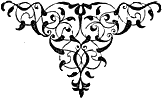| Bouchot navigation page, Preface, Chapter 1, Chapter 3, Chapter 4, Chapter 5, Chapter 6, Chapter 7, Chapter 8, Chapter 9, Index |
CHAPTER II.
 ONSIDERING the influence of printing on the book trade of the fifteenth century, as referred to in the preceding pages, the dealers in manuscripts were not disposed to give way at the first blow. An entire class of workmen would find themselves from day to day without employment if the new art succeeded ; these were the copyists, miserable scribes, who for meagre remuneration frequented the shops of the merchants, where they / p.34 / transcribed manuscripts by the year. Before printing the publication of books was so effected, and the booksellers were rather intermediaries between the copyist and the buyer, than direct dealers having shops and fittings complete. It is evident that they would not provide themselves with these costly books long in advance without being sure of disposing of them.
ONSIDERING the influence of printing on the book trade of the fifteenth century, as referred to in the preceding pages, the dealers in manuscripts were not disposed to give way at the first blow. An entire class of workmen would find themselves from day to day without employment if the new art succeeded ; these were the copyists, miserable scribes, who for meagre remuneration frequented the shops of the merchants, where they / p.34 / transcribed manuscripts by the year. Before printing the publication of books was so effected, and the booksellers were rather intermediaries between the copyist and the buyer, than direct dealers having shops and fittings complete. It is evident that they would not provide themselves with these costly books long in advance without being sure of disposing of them.Small as was the remuneration of the writers, it was much to them ; and they were naturally the first to protest against the new invention. At the same time, their opposition and that of the booksellers was soon overcome, swamped, and choked by the growing crowd of printers. Then, as always happens in similar cases, in place of fighting against the current, most of the former workers in manuscript followed it. The writers designed letters for engraving in wood, the booksellers sold the printed works, and some of the illuminators engraved in relief or cast their histoyres. For a long time these last continued to decorate books with the ornamental drawings with which they had adorned the manuscripts, and so contributed to form the fine school of illustrators who carried their art to so high a point from the end of the fifteenth century.
As previously related, the revolution of Mayence caused the flight of a crowd of artisans who found their liberty suddenly compromised by the conqueror. The want of money at this time always brought a diminution of patronage, and working printers have been at all times tenacious of their privileges. It so happened that their guild, in place of remaining established at Mayence many years longer, was, as it were, turned out, scattered to the four cardinal points by the disper- / GERMAN PRINTERS DISPERSED THROUGH EUROPE. p.35 / sion of its members, and scattered many years before the natural time. In point of fact, in the common order of things, a workman here and there quits the principal workshop to try the world. He makes his way timidly, unconscious apostle of a marvellous
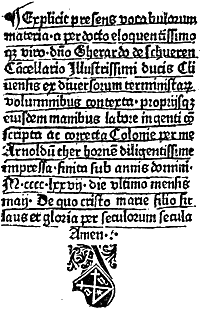 printer, of Mayence. |
It is to be remarked that the Mayence men did not turn towards Holland. Is it that they found there the descendants of Laurent Coster firmly established in their workshops ? Must the coexistence, the simultaneous advance, of the invention in Germany and in the Low Countries be admitted ? It is a secret for us and for many others, but we know for certain that Flemish printers were established at Utrecht in 1473, at Delft, Bruges, Gouda, Zwoll, Antwerp, and Brussels. / CAXTON AND THE FIRST ENGLISH PRINTERS. p.37 / At Louvain there was besides John of Westphalia, who published in 1474 a work of Peter Crescens, and several other works.
Colard Mansion was printing at Bruges about 1473 ; and was employed by William Caxton, who had been for some years trading as a merchant in the Low Countries, to print the " Recuyell of the Histories of Troy," by Raoul Le Fevre, which Caxton had translated into English at the command of Queen Margaret. This was issued in 1474, and was the first book printed in the English language. In 1475 or 1476 Caxton returned to England with a fount of types, which he had employed Mansion to cut and cast for him, and established himself as a printer in the precincts of Westminster Abbey. In 1477 he produced the first book printed in England, " The Dictes and Sayings of the Philosophers," followed by a large number of important works, many of them written or translated by Caxton himself. Thus was typography firmly established in England ; and Caxton's immediate successors, Wynken de Worde, Richard Pynson, William Machlinia, have had a glorious roll of followers, which has never been broken to this day. From Westminster the art spread in England to Oxford, where Theodoricus Rood, from Cologne, printed an Exposicio Sancti Jeronimi in 1478 ; and to St. Albans in 1480 by a printer who has never been identified, and who produced the famous "Chronicle" and "Boke of St. Albans."
The invasion, we see, had been most rapid. In less than fifteen years, every important city had followed the movement, and was ready to establish printing offices. If we may credit a certain controverted docu- / p.38 / ment, Charles VII. had on the 3rd of October, L458, [lit.] sent to Mayence one of the best medal engravers of the Mint of Tours to study the process of which marvels were spoken : " The 3rd of October, 1458, the King having learned that Messire Guthenberg, living at Mayence, in the country of Germany, a dexterous man in carving and making letters with a punch, had brought to light the invention of printing by punches and types, desirous of inquiring into such a treasure, the King has commanded the generals of his mints to nominate persons well instructed in the said cutting and to send them secretly to the said place to inform themselves of the said mode and invention, to understand and learn the art of them, in order to satisfy the said Lord King ; and it was undertaken by Nicholas Jenson, who took the said journey to bring intelligence of the said art and of the execution of it in the said kingdom, which first has made known the said art of impression to the said kingdom of France" (Bibliothèque de l'Arsenal, Hf 467, pp. 410, 411).
Nicholas Jenson on his return met with a cool reception from Louis XI., who did not continue the works of his father. It may be supposed that this coolness was the cause of his expatriating himself and retiring to a place where his industry could be better exercised. Ten years after the above mission we find him established at Venice, his art of engraver of letters joined to that of printer. His Eusebius, translated by Trapezuntius, and his Justinian, were composed in 1470 with such marvellous and clear types that from that day the best typographers have imitated his founts. In spite of its success, he did not confine himself to these letters, / NICHOLAS JENSON. p.39 / but he made use also of Gothic, in which he printed by preference pious books.
In spite of the attempts of Jenson in the name of the
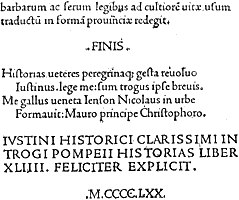
King of France—that is, if these attempts ever took place in the manner indicated above—the invention was not known to have commended itself to the powerful / p.40 / university of Paris. In general, and especially for the introduction of innovations in that learned body, it was necessary to fight, to strike without much chance of success, save in case of having acquaintance in the place. We have seen John Fust, obliged suddenly to retake the road to Germany, in a fair way to find himself taxed with sorcery, not an inconsiderable matter. For others the sale of unauthorised books had had most unhappy consequences unless the Parliament intervened. So ten years had passed since the journey of Jenson, and ten or twelve since the first manifestations of typography at Mayence, without the diabolical discovery finding admittance to the Sorbonne. A still more extraordinary thing, a Cologne printer issued about 1472 a small folio in Gothic type, thirty-one long lines to a page, which was a work written in French. The Histoires de Troyes of Raoul Le Fevre, chaplain of the dukes of Burgundy, first found a publisher in Germany, and soon after another in England, before a single press was definitely installed at Paris.
As we have said of Peter Schoeffer, numerous German students were in the university, where they pursued their studies, and frequently remained later as masters. It has been found that in 1458 a former student of Leipzig named John Heinlein, a native of Stein, in the diocese of Spire, entered as regent of the college of Burgundy, from whence he passed to the Sorbonne in 1462, the year of the troubles in Mayence. After the manner of latinising names so common at that time, he called himself Lapidanus, from the name of his native place, which means Stone in German. / THE FIRST PRINTING IN PARIS. p.41 / Heinlein met in Paris a Savoyard, William Fichet, born in 1433 at Petit Bornand, who became an associate of the Sorbonne about 1461, and finally rector in 1468. These two men were great friends, and their particular instincts attracted them to men of elevated studies. They divined at once the enormous help printing would bring to their work. Besides, it grieved them to see through the whole of France, especially in Touraine, German colporteurs carrying on their trade under cover of other commerce, a practice from which the most grave inconveniences might result. It occurred to them that to prevent fraud they would themselves create a printing establishment ; but if they deliberated on it, it must have been in secret, for the registers of the Sorbonne are silent on their enterprise. If Fichet conceived the idea, it may be believed that, from his German origin, Heinlein put it into execution. M. Philippe thinks that he was formerly at Basle. In all probability it was from that city he tried to obtain his workmen. In 1468 six years had elapsed since the craftsmen were dispersed and fled from Mayence. At all events, it was from Basle that Ulrich Gering, Michael Freyburger, and Martin Krantz, printers recommended to the two Sorbonnists, departed, and in due course arrived in Paris. Of these three men, who were the first to establish a printing office on the French side of the Rhine, Ulrich Gering was a student as well as a printer, so was Freyburger, originally of Colmar. Krantz was a letter-founder, and the only real workman of the three companions.
We have often regretted with regard to these men, as also to Gutenberg, Fust and Schoeffer, that no / p.42 / really authentic portrait has transmitted their features to us. Every one will recall the fur cap and loose pantaloons of the mediocre statue at Mayence, but there is really no portrait of Gutenberg. As to Gering, M. Philippe, in his Histoire de l'Origine de l'Imprimerie à Paris, publishes a grotesque figure muffled in the ruff of the sixteenth century, after a picture preserved at Lucerne, but for which much cannot be said. Lacaille, in his Histoire de l'Imprimerie, gives a full-length portrait of Gering, said to be taken from a painting in the College Montagu.
The workshop of the three Germans was set up within the walls of the Sorbonne—in œdibus Sorbonnicis—in 1469. There they set to work at once, their printing establishment consisting simply of a room, none too light, a table, a press, and formes. Krantz doubtless struck the types chosen by the Sorbonnists, for there were then in use two sorts of letters : German Gothic and Roman. They kept to the Roman, as being more round and clear ; and as soon as they obtained matrices and cast their type, they entered on their task with ardour.
The tendencies of Fichet and Heinlein were not towards transcendent theology, but rather towards the literature of the ancients and contemporary rhetorical works. Besides, it may be said, considering that men are far from perfect, Fichet counted on making the authorised presses serve his own purpose. We find him publishing a treatise on rhetoric in quarto in 1471 ; meantime he supervised the work confided to his artists. They commenced with a large volume of " Letters" of Gasparin of Bergamo, which was set up in quarto with
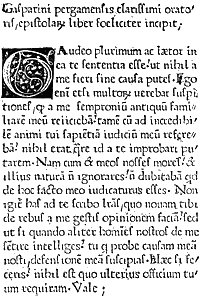
the Roman type, the form of which had been accepted. At the end of the work, the impression of / p.44 / which cost much time—possibly a year—the three printers placed a quatrain in Latin distichs, which is at once a statement of identity and a promise for the future.
If we try to apportion to each of the three printers his share in the making of the book, it may be supposed that the intellectual part of the composition and the correction
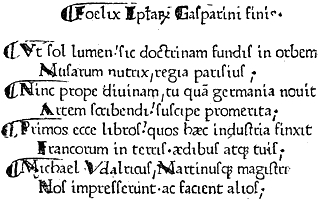
fell to Freyburger and Gering, while the heavier work of founding, placing in formes, and press work fell to Krantz. This essay, satisfactory as it appeared, was far from perfection. The first Parisian printers had multiplied abbreviations and irregular contractions, and enormous difficulties and inevitable faults ensued. Further, either they had more than one punch, or the leaden matrix was deformed, for the characters fre- / THE FIRST PRINTING IN PARIS. p.45 / quently differ. At the same time, we must commend them for having used the æ and œ, which were uniformly
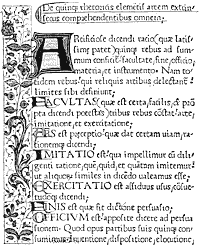
written e in the manuscripts, thus giving rise to errors without number. Their punctuation was the comma, semicolon, and full stop.
Fichet and Heinlein had become the modest librarians of the Sorbonne, and this new employment gave them greater facilities for surveillance. The printing office did not remain inactive. It issued successively the " Orthography" of Gasparin of Bergamo, the " Letters" of Phalaris, two books of Æneas Sylvius, the " Conspiracy of Catiline" of Sallust, the " Epitome of Titus Livius" of Florus, and finally the " Rhetorics" of William Fichet, which, if we may credit a letter addressed to Bessarion, was finished in 1471. Following came the "Letters" of Bessarion, the Elegantia Latinæ Linguæ of Valla, the first folio volume from the Sorbonne presses ; and others, thirteen volumes in 1470-71 and seventeen in 1472.
At the end of 1472 the workshop was somewhat broken up, Fichet having left for Rome and Heinlein preaching in Germany. The three printers had shown by their works that they were in earnest ; besides, they had from the first gratuitously distributed copies among the nobles, who, being accustomed to pay highly for manuscripts, did not fail to note the difference. The associates then resolved to quit the Sorbonne and create an establishment for themselves ; their patrons being no longer there to sustain them in case of failure, and in giving up their presses and types it may be judged that they were not without anxiety on that point.
Their oldest dated book, the Manipulus Curatorum of Montrochet, was also the first that they printed in their new quarters, at the sign of the " Golden Sun" in the Rue St. Jacques. They remained united up to the year 1477, when Gering alone printed at the " Golden
/ EARLY BOOK ILLUSTRATION. p.47 /
Sun," but he obtained associates, George Mainyal in 1480 and Berthold Rembold in 1494, who lived with him in the Rue de la Sorbonne, where he established himself on leaving the Rue St. Jacques. Ulrich Gering died on the 23rd of August, 1510, after a half-century of work.
The movement inaugurated by the Sorbonne was promptly followed. German workmen opened their shops nearly everywhere in France ; then the French themselves scattered. At Lyons in 1472 a Frenchman was established, the same at Angers, Caen, Metz, Troyes, Besançon, and Salins. But in the central provinces we find Henry Mayer at Toulouse, John Neumeister at Albi ; in the east Metlinger at Dijon ; and Michael Wensler, of Basle, at Macon, among others, about 1493.
We have now arrived at an epoch of greater efforts. The Lyons printers used ornamental letters, from which were developed engravings in the Book. Since the block books illustration had been neglected, as the means were wanting to distribute the plates here and there in the forme ; Schoeffer still employed initial letters in wood very like vignettes. John Fust was now dead, but Peter Schoeffer continued to print without intermission.
If we search for the precise epoch in which illustration appeared in the history of the Book, we shall perhaps have to go back to the time of Albert Pfister, printer of Bamberg, who issued in 1461 an edition of the "Fables of Ulrich Bohner" with a hundred and one figures on wood. This may be said to be the unconscious combination of xylography with typography, a kind of transformation of old elements to
/ p.48 / new things without other importance ; art had no place in this adaptation.
Up to this time Germany had not, in its school of painters or miniaturists, men capable of giving a personal impulse to ornament. In the German editions of the block books the influence of Van Eyck had made itself felt very sensibly, and the Flemish had preserved their supremacy on this point ; on the other hand, the German printers who went to seek their fortune in Italy fell into the middle of a circle admirably prepared to receive them and to communicate their ideas to them. It is believed that the first book printed in Italy with woodcuts in the text and with an ascertained date is the work of a German established at Rome, Ulrich Hahn, in 1467. An account in the Annuaire du Bibliophile, which, being without citation of authority, we quote for what it is worth, relates that Ulrich Hahn was established as a printer at Vienna about 1462, but was driven thence by the publication of a pamphlet against the burgomaster of the city, and was attracted to Rome by Torquemada, who confided to him the impression of his work the Meditationes. Hahn was an engraver, as were also most of his confrères at that time—that is, he cut in relief designs to be intercalated in the text—and Passavant relates that the designs of the Meditationes were from compositions of Fra Angelico, who died in 1455. Be that as it may, the book, the printing of which was finished on St. Sylvester's Day, 1467, is the first known with engravings, and only three copies of it exist : one at Vienna, one at Nuremberg, and one in Lord Spencer's library ; it is composed in Gothic type in folio.
Illustration found a true artist at Verona, Matteo Pasti, who furnished designs for a volume on military art by Valturius, printed in Roman characters in folio, at the expense of John of Verona, and dedicated to Sigismond Pandolfi. Pasti's eighty-two figures are simple outlines, and we here reproduce one of the
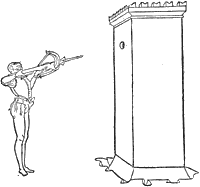
principal—an archer shooting at a butt. Published in 1472, the volume of Valturius followed soon after the Meditationes, but the engravings enable us to see how the Italian process, consisting mostly of lines / p.50 / without shadows, differed from the Dutch and German. One thing to be remarked here is the purity of the design, in spite of the roughness of the engraving ; we see in these figures Italian art at its height, despite the somewhat coarse translation of the wood-cutter.
At Venice the German inventors had reaped their harvest. At the end of the fifteenth century, fifty years after the invention of typography, the printing offices and booksellers' shops were counted by hundreds. It was in this city that for the first time a title with frontispiece carrying indication of the contents, the place, the date, and the name of the printer, was given to the Book. We give here this ornamental title, placed before a Calendario of John de Monteregio, printed by Pictor, Loslein, and Ratdolt in 1476, folio.
The German Erhardt Ratdolt was probably the promoter of these innovations. He soon afterwards published the first geometrical book with figures, the " Elements of Euclid," 1482, folio ; in the same year he produced the Poeticon Astronomicum of Hyginus, previously printed at Ferrara, with illustrations on wood of excellent design, but laboriously and unskilfully engraved. Yet the art of the Book could not remain mediocre in this city, where the artists were creating marvels. John of Spire and afterwards Nicholas Jenson, the emigrant from France, of whom we have spoken above, had created, after Italian manuscripts, that Roman letter, the primitive type of which has come down to our time very little retouched. At the death of Jenson in 1481, his materials passed into the hands of Andrew d'Asola, called Andrea Torresani, who did not allow the good traditions of his master to die, and who produced / EARLY BOOK ILLUSTRATION. p.51 / among others a book bearing signatures, catchwords, and paging (" Letters of St. Jerome," 1488). Torresani was the father-in-law of Aldus Manutius, who was to be for ever illustrious in the art of printing at Venice, and raised his art to the highest perfection.
But if decoration by means of relief blocks found
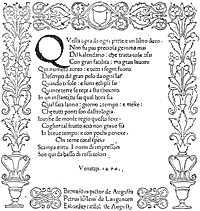
a favourable reception in Italy and, above all, a group of artists capable of carrying it to success, there were at the same time other experiments conceived in a different way. The discovery of Maso Finiguerra gave to the art a new process of reproduction, and printing presses had now to render possible and practi- / p.52 / cable the working of engraved plates. In order to make that which follows comprehensible, we enter into a few technical details, the whole subject having been so admirably and fully treated by MM. Delaborde and Duplessis.
In the engraved wood block, as in the printing type, it is a projection in the wood or metal which, being inked and passed under a press, leaves on paper its lines in black. Naturally then the intercalation of an engraving of this kind in typographical composition is made without difficulty, and the impression of both is taken at once. On the other hand, a line engraving is obtained from incised lines on a plate of copper ; that is, an instrument called a burin traces the lines, which are filled with greasy ink. These incised lines only are inked. The surface of the plate is cleaned off to avoid smudging. The sheet of paper destined for the impression has then to be made very pliable, so that at the striking of the press it runs, so to speak, to find the ink in the lines and hold it. It is therefore impossible to take a text from relief characters at the same time as an engraved plate.
However, this kind of reproduction, which, contrary to that from wood, allowed of half-tints or toning down, attracted in good time the workers at the Book. It appeared to them possible to reconcile the two printings by the successive passage of the same sheet of paper through the press, to receive at first the impression from the type and afterwards to find the ink deposited in the incisions in the copper. The first manifestation of this new method of illustration was made at Florence, the home of line engraving, by Nicholas di
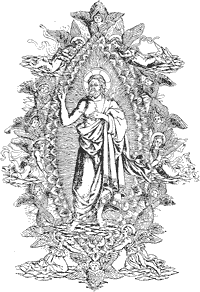
Lorenzo in 1477, for the work of Antonio Bettini, of Siena, called El Monte Santo di Dio. Here the artists / p.54 / were never known. Common opinion has it that Baccio Baldini borrowed from Sandro Botticelli the subjects of his plates. Italian engraving always seeks its source in Pollajuolo, Botticelli, and Baldini. It is not the simple work of a niellist, but it had not yet reached perfection either in the work or in the impression ; the illustrations of the Monte Santo are proof of this, as are also those of the Dante, by Baldini, in 1481, for the same Nicholas di Lorenzo. From this we reproduce the Misers.
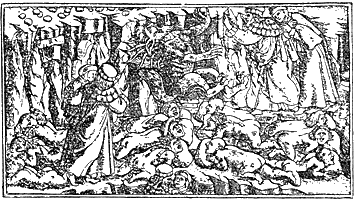
At this epoch engravings from the burin were taken with a pale ink, the composition of which is very different from the fine black ink of Schoeffer as well as of the old Italian printers. And besides in most cases the proofs were obtained with the frotton, like the ancient block books, an eminently defective process. The press was not yet well adapted to the delicate work of line engraving, and the workmen, who did not apply the plates until after the text was printed, pre- / EARLY ILLUSTRATION IN ITALY. p.55 / ferred not to risk the loss of their sheets by the use of inappropriate presses. These, with the insignificant attempts made by the Germans in 1479,*
* Breviarium ecclesie Herbipolensis : Et. Dold., 1479, folio, copper plate engravings.
---------------------------
are the beginnings of the process of line engraving in the ornamentation of the Book. In fact, the process failed to take its due position for want of a more convenient mode of working. Relief engraving had got ahead ; with it the sheets used for the impression did not require working more than once to register the figures with the text ; in a word, the labour was not so great. A century had to pass before line engraving completely dethroned the vignette on wood, a century in which the latter attained its height, and showed what able artisans could make of a process apparently the least flexible.
Not to leave Italy, which had the honour of making the book with engraved illustrations known to the world, we pass by some years, during which Arnold Bucking gave at Rome a Cosmographia of Ptolemy, 1478, with incised plates, which is the first printed atlas that was produced, whilst as regards ordinary publications there appeared in all parts classical and Italian works, such as Cicero, Virgil, Tacitus, Pliny, Eusebius, among the ancients, and Dante, Petrarch, Boccaccio, etc., among moderns. Among the editions of Dante, we may cite that of Peter of Cremona, dated 18th November, 1491, with one engraving to each canto, of which the earlier are after Botticelli, and perhaps drawn by him directly on the wood. Passavant believes these figures to be cut in relief in the metal. On some of the plates there / p.56 / is a signature, a Gothic b, the signification of which leaves a free field for conjecture and perhaps for error. Copies of this book with the complete series of twenty plates are extremely rare ; one in the Hamilton Palace Library sold in May, 1884, for £380 ; the Royal Library of Berlin recently agreed to pay £1,200 for a proof set of the plates.
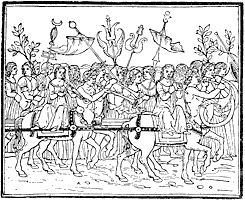
As we shall see later apropos of German vignettes of the same period, the characteristic of Italian engraving was sobriety, the complete absence of useless work and the great simplicity of the human figure. This special manner will be found in the famous edition of the Hypnerotomachia Poliphili of Francis Colonna,
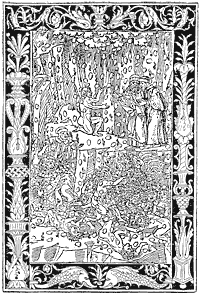
printed in 1499 by Aldus, copied sixty years later by a French printer, and lately reproduced in reduced size.
The Italian illustrators, whether they were working in wood, or, as some writers have it, in metal, adroitly brought their figures forward by contrasting some rudimentary work in the persons with the more accentuated and often stippled ground, which formed a dark background. This was also the ordinary process in their ornaments, among the most interesting of which are the borders of the plates to an edition of Dante by Bonino de Bonini, Brescia, 1487, of which a specimen is here reproduced.
If we return from Italy, which then took the lead, to Germany, a school of Formschneiders is found about the year 1470 at Augsburg, whose secluded workshops were of no benefit to the booksellers. These ill-advised artisans went still further. Apparently furious to see printing so widely spread as to render their bad woodcuts difficult to get rid of, they united in a body to interdict Gunther Zainer and Schüssler from putting engravings into their books. They must nevertheless have come to an ultimate arrangement, for Zainer printed in 1477 a book on chess by Jacopo da Cessole, with vignettes. He was one of the few German printers who employed Roman characters in place of the Gothic of Peter Schoeffer. At Cologne in 1474 Arnold Ther Hoernen published a work entitled Fasciculus Temporum, with small illustrations engraved on wood. A Bible without date contains most interesting illustrations. As to the celebrated Todtentantz, or " Dance of Death," published about 1485, it contains forty-one relief plates of the most ordinary kind, the same as in the " Chronicle of Cologne" of 1499, of which the figures, though less German, less
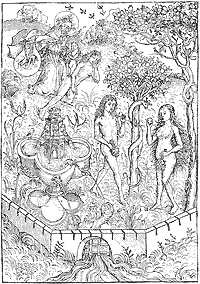
distorted, are worth little compared with those of the Nuremberg books, more German, but more artistic.
At Nuremberg, Antony Koburger, called by Badius the prince of booksellers, directed an immense establishment, employing more than a hundred workmen, without counting smaller houses at Basle and Lyons. Koburger was a capable and a fortunate man. He had at first put forth a Bible very indifferently illustrated with the cuts of the Cologne Bible, but he had before him something better than copying others. Michael Wohlgemuth, born at Nuremberg in 1434, was then in the full vigour of his talent. To his school the young Albert Dürer came to study ; and as he was able to draw on wood as well as to engrave on copper and paint on panel, Koburger was attracted to him, and engaged him to make a set of illustrations for a book. The projected work was the Schatzbehalter, a sort of ascetic compilation, without interest, without arrangement. Michael Wohlgemuth set to work ; and, thanks to the ability of his engravers, of whom William Pleydenwurff was probably one, Koburger was able to put the book on sale in the course of 1491 in three hundred and fifty-two folios of two columns. Without being perfection, the designs of Wohlgemuth, very German, very striking, present the vigour and merit of the future school of Nuremberg. The figure is no longer a simple line, in the manner of the block books, but a combination of interlaced cuttings, intended to imitate colour. Those representing the creation of Eve and the daughter of Jephthah are here reproduced. In the search for harmony between the text and engravings of this curious work, we shall find grace
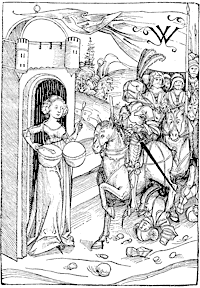
and gaiety laid aside, on the other hand a freedom and boldness that interest and permit us to appreciate at their value the Nuremberg artists and Koburger, the printer. In fact, the German artists are more individual, each one taken by himself, than the Italian illustrators could be, condemned as they were to the hierarchical commonplace and to a certain form of idealism into which the art of Italy entered little by little. The German painters, naturalists and believers, presented their heroes in the image of that robust nature that was before their eyes. It was in this rude and unpolished spirit that Michael Wohlgemuth decorated the Schatzbehalter ; he also composed the designs for the "Nuremberg Chronicle" of Dr. Hartman Schedel, printed by Koburger in 1493.
With Dürer, at the latter end of the fifteenth century, the Book was no more than a pretext for engravings. Thausing, his biographer, says that the great artist felt the necessity of designing an Apocalypse at Rome at the time that Luther was premeditating his religious revolution in face of the worldly splendours of the pontifical court. The " Apocalypse," published in 1511 in Latin, with Gothic characters, was an album of fifteen large wood engravings. The Four Horsemen is the best of these plates, and the boldest ; but in this gross fancy, in these poor halting old hacks, the fantastic and grand idea which the artist meant to convey can hardly be seen. It may be said the genius of Dürer was little adapted to vignettes, however large they were, and did not easily lend itself to the exigencies of a spun-out subject. The title of his " Apocalypse" is of its kind a curious example of German genius, but, in spite of its
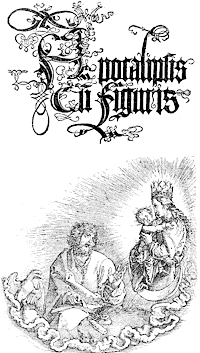
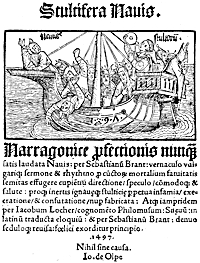
vigour, it does not please like an Italian headpiece or like a French or Flemish frontispiece. The other works of Dürer published in the fifteenth century, " The Life / THE " SHIP OF FOOLS." p.65 / of the Virgin" and " The Passion," were also sets of prints that received a text in the sixteenth century.
For the rest of his illustrations Dürer belongs to the sixteenth century, and we shall have occasion to recur to his works. At present it remains to speak of a
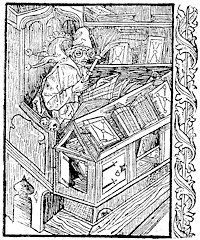
curious work printed at Basle by Bergman de Olpe in 1497, which appears to be the first comic conception of fifteenth century artists : the Navis Stultifera, or " Ship of Fools," of Sebastian Brandt. This work of the school of Basle lacks neither originality nor vigour. At the time when it was published its success was / p.66 / immense, from the strange tricks of its clowns, with fools' caps, with which every page was adorned. Alas ! the best things fall under the satire of these jesters, even the Book and the lover of books, if we may judge by the sarcasms against useless publications volleyed by the personage here reproduced. " I have the first place among fools. . . . I possess heaps of volumes that I rarely open. If I read them, I forget them, and I am no wiser." Brunet sees in these humorous caricatures more art than is really to be found in them. Their value is owing more to their spirit and humour than to any other artistic merit. Even the engraving is singularly fitted to the subject, with its peculiar cutting, somewhat executed in hair-lines. The designer was certainly not a Holbein, but he is no longer the primitive artisan of the first German plates, and his freedom is not displeasing.
We have before spoken, apropos of engraving by the burin in Italy, of the small share of Germany in the essay at illustration by that means, and we do not see a real and serious attempt in the two little coats of arms in copper plate in the Missale Herbipolense, printed in 1479.
The Flemish had not taken any great flights in the midst of this almost European movement. The school of Burgundy, whose influence was felt in all the surrounding countries, had lost its authority in consequence of the progress realized at Mayence. Without doubt the great Flemish artists were there, but they were honoured painters, and their inclination did not descend to seeking the booksellers beyond making them offers of service. Besides, the first of these, / THE BOOK IN THE LOW COUNTRIES. p.67 / officially established in Flanders, were two Germans, John of Westphalia and John Veldener, of Cologne, who established themselves in the university of Louvain in 1473, three years after the first Paris printers. John of Westphalia, who took his own portrait for his mark, edited the Fasciculus Temporum, a book which had enormous success in the fifteenth century.
At Haarlem, in spite of the block books attributed to Laurent Coster, illustration was backward. About 1485, a Dutch translation of the Malheurs de Troye of Le Fevre was put on sale. This French book was published at Cologne before France possessed the smallest typographical workshop. At Bruges Colard Mansion illuminated the cuts of his Metamorphoses of Ovid in 1484. Simple engraving appeared to him far remote from manuscripts of which the vogue had not yet passed away. At Zwoll Peter van Os, the publisher, cut up and used the xylographic plates of the Biblia Pauperum, while the master à la navette, John of Cologne, an artist in the best sense of the word, was ornamenting certain popular publications with his designs. At Utrecht Veldener came from Louvain to establish a workshop. He published for the second time a Fasciculus in 1480 ; he created a style of decoration with flowers and leaves, which shortly after developed into the trade of Rahmenschneiders. Antwerp had attracted Gerard de Leeu from Gouda, and he produced the romance of Belle Vienne. Schiedam had an inventive engraver who illustrated an edition of the Chevalier Delibéré of Oliver de la Marche, in folio, with Gothic letters, after 1483, as we read in the colophon:—
|
" Cet traittié fut parfait l'an mil Quatre cens quatre vings et trois Ainsi que sur la fin d'avril Que l'yver est en son exil, Et que l'esté fait ses explois. Au bien soit pris en tous endrois De ceulx à qui il est offert Par celui qui Tant a souffert, La Marche."
|
The French language, bright and harmonious, thus found hospitality in other countries. For many examples of French books published abroad, we cannot cite one German work printed in France. Spreading from the north to the south, typography had from 1490 its two principal centres at Paris and Lyons. After the success of the three Germans at the Sorbonne, events took their own course. In 1474 Peter Cæsaris and John Stol, two students who had been instructed by Gering and Krantz, founded the second establishment in Paris, at the sign of the " Soufflet Vert ;" and they printed classical works. Ten years later appeared Antony Vérard, Simon Vostre, and Pigouchet, the first of whom gave to French bookselling an impulse that it has not since lost ; but before them Pasquier-Bonhomme published his Grandes Chroniques in 1476, three volumes folio, the oldest in date of books printed at Paris in French.
The French school of illustration was at its most flourishing point at the end of the fifteenth century, but solely in miniature and ornamentation by the pencil. The charming figures of the manuscripts had at this time a Flemish and naturalistic tendency. The most / FRENCH SCHOOLS OF ORNAMENT. p.69 / celebrated of the great artists in manuscripts, John Foucquet, could not deny the source of his talent nor the influence of the Van Eyck school, yet the touch remained distinctly personal. He had travelled, and was not confined to the art circles of a single city, as were so many of the earliest painters of Flanders. He had gone through Italy, and from thence he transported architectural subjects for his curious designs in the Heures of Etienne Chevalier, now at Frankfort ; a precious fragment of it is preserved in the National Library of Paris. Side by side with this undoubted master, whose works are happily known, lived a more modest artist : John Perréal, called John of Paris, painter to Charles VIII., Louis XII., and Anne of Brittany.
In joining with these two masters, to serve as a transition between Foucquet and Perréal, John Bourdichon, designer to the kings of France from Louis XI. to Francis I., we obtain already a not despicable assemblage of living forces. Without doubt these men were not comparable either with the admirable school of Flanders, or the Germans of Nuremberg, or the masters of Italy ; but, moderate as we may deem their merit, they did their tasks day by day, painting miniatures, colouring coats of arms, rendering to the kings, their masters, all the little duties of devoted servants without conceit, and preparing, according to their means, the great artistic movement in France of the seventeenth century. That these men, leaving the brush for the pencil, devoted themselves to design figures on wood, is undeniable. It is said that one of them followed Charles VIII. to the Italian wars, / p.70 / and probably sketched the battles of the campaign as they took place. Now in the books published at this epoch in France we meet with vignettes which so very nearly approach miniatures, that we can easily recognise in them French taste and finish. Such are, for example, the illustrations of the Mer des Histoires, printed by Le Rouge in 1488, where suppleness of design is blended in some parts with extraordinary dexterity in engraving. Nevertheless, others leave something to be desired ; they maim the best subjects by their unskilful line and their awkwardness of handling. Were not these engravers on wood printers themselves : the Commins, Guyot Marchants, Pierre Lecarrons, Jean Trepperels, and others ? We are tempted to see in certain shapeless work the hasty and light labour of an artisan hurried in its execution. As mentioned above, the part taken by the booksellers in the making of the plates does not make our supposition in itself appear inadmissible.
Printing had been established about twenty years in Paris when Philip Pigouchet, printer and engraver on wood, began to exercise his trade for himself or on account of other publishers. Formerly bookseller in the University, he transported his presses to the Rue de la Harpe, and took for his mark the curious figure here reproduced. At this moment a veritable merchant, Simon Vostre, conceived the idea of putting forth Books of Hours, until then disdained in France, and of publishing them in fine editions with figures, borders, ornaments, large separate plates, and all the resources of typography. The trials made at Venice and Naples between 1473 and 1476 warranted the / BOOKS OF HOURS. p.71 / enterprise. Entering into partnership with Pigouchet, the two were able on the 17th of April, 1488, to place on sale the Heures à l' Usaige de Rome, octavo, with varied ornaments and figures. The operation having succeeded beyond their hopes, thanks to the combination of the subjects of the borders, subjects that could
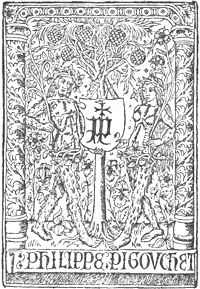
be turned and re-turned in all ways so as to obtain the greatest variety, Simon Vostre reapplied himself to the work, and ordered new cuts to augment the number of his decorations. Passavant's idea is commonly received that the engraving was in relief on metal ; the line / p.72 / in it is very fine, the background stippled, and the borders without scratches. Wood could not have resisted the force of the press ; the reliefs would have been crushed, the borders rubbed and broken. In all the successive editions hard work and wear are not remarked, and we are forced to admit the use of a harder material than the pear or box-wood of ordinary blocks.
According to his wants, Simon Vostre designed new series of ornaments. Among them were histories of the saints, Biblical figures, even caricatures against Churchmen, after the manner of the old sculptors, who thought that sin was rendered more horrible in the garb of a monk. Then there were the Dance of Death and sibyls, allying sacred with profane, even the trades, all forming a medley of little figures in the margins, in the borders, nestled among acanthus leaves, distorted men, fantastic animals, and saints piously praying. The Middle Ages live again in these bright and charming books, French in their style, imbued with good sense and perfect toleration.
The Book rose under Simon Vostre and Philip Pigouchet to the culminating point of ornamentation. Here design and engraving improve and sustain each other. It is not only the stippled backgrounds of the borders that please the eye. And who was this unknown designer, this painter of bold conceptions, whose work is complete in little nothings ? However, the large full-page figures have not always an originality of their own, nor the French touch of the borders. Thus that of the Passion here reproduced is inspired line for line by the German, Martin Schongauer. Are
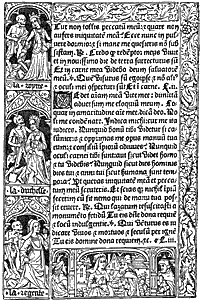
we to suppose, that duplicates of blocks passed between France and Germany, or was a copy made by
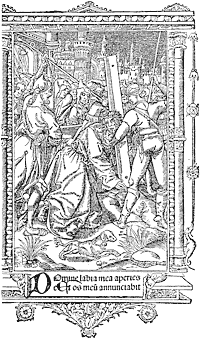
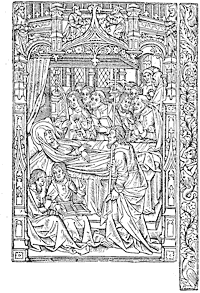
a French designer ? It is difficult to say. Still the coincidence is not common to all the missals of the great Parisian bookseller. The Death of the Virgin / p.76 / here reproduced is an evident proof of it. It forms part of the 1488 book, and is a truly French work.
It may be said that from the artistic association of Philip Pigouchet and Simon Vostre was born the art of illustration of the Book in France ; they worked together for eighteen years, in steady collaboration, and, as far as we know, without a cloud. At Vostre's commencement in 1488 he lived in the Rue Neuve Notre Dame, at the sign of " St. Jean l'Evangeliste ;" and in 1520 he was still there, having published more than three hundred editions of the Missal, according to the use of the several cities.
Contemporary with Simon Vostre, another publisher was giving a singular impulse to the Book by his extreme energy, true taste, and the aid of first-class artists. Antony Verard, the most illustrious of the old French booksellers, was a writer, printer, illuminator and dealer. Born in the second half of the fifteenth century, he established himself in Paris on the Pont Notre Dame, both sides of which were then covered with shops, and about 1485 commenced his fine editions with a " Decameron" in French by Laurent de Premierfait. M. Renouvier remarks in his notice of Verard that his first books were not good, the plates were often unskilful, and were probably borrowed or bought from others ; this may be very well understood in a beginner whose modest resources did not permit bold enterprises ; the figures were in most cases groundworks for miniatures, outlines and sketches rather than vignettes.
Antony Verard was accustomed to take a certain number of fine copies on vellum or paper of each book

published by him, in which authorised painters added miniatures and ornaments. It is curious now to find what the cost to one of the great lords of the court of Charles VIII. was of one of these special copies in all the details of its impression, and we find it in a document published by M. Senemaud in a provincial journal (Bulletin de la Société Archéologique de la Charente, 1859, part 2, p. 91), which enables us at the same time to penetrate into a printing office of a great French publisher / p.78 / of the fifteenth century. According to this document, Verard did not disdain to put his own hand to the work, even to carrying the book to the house of his patron if he were a man of consequence. It is an account of Charles de Valois-Angoulême, father of Francis I. He was then living at Cognac ; and he ordered Verard to print separately for him on vellum the romance of Tristan, the "Book of Consolation" of Boetius, the Ordinaire du Chrétien, and Heures en François, each with illuminations and binding. In the detail of expenses Verard omits nothing. He reckons the parchment at three sous four deniers the sheet, the painted and illuminated figures at one écu the large and five sols the small. We give here the outline of one of the plates of the Tristan, ordered by the Duc d'Angoulême, reduced by two-thirds, and from it it may be judged that the profession of the illuminator, even for the time, was by no means brilliant. The binding was in dark-coloured velvet, with two clasps with the arms of the Duke, which cost sixty sous each. The work finished, Verard took the route for Cognac, carrying the precious volumes. He was allowed twenty livres for carriage ; and this brings the total to 207 livres 10 sous, equivalent to £200 to £240 of present money.
Verard had preceded Simon Vostre in the publication of books of hours, but his first volume dated 1487 was not successful for the want of borders and frontispieces. At the most he had introduced figures intended for illumination, which, as well as the vignettes, were cut in wood. In 1488, the same year that Simon Vostre commenced his publications, Verard put forth, by "command of the King our lord," the book called / BOOKS OF HOURS. p.79 / the Grandes Heures, which is in quarto, Gothic letter, without paging, twenty lines to the full page. This Grandes Heures contained fourteen engravings, large
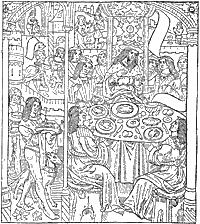
borders in four compartments, smaller subjects and initials rubricated by hand. He also published more than two hundred editions between 1487 and 1513, and among them the Mystère de la Passion, with eighty / p.80 / figures ; the Grandes Chroniques, in three folio volumes, printed by John Maurand ; the Bataille Judaïque of Flavius Josephus ; the Legende Dorée of Voragine, all books for which he called to his aid rubricators, illuminators, and miniaturists. From the first he had two shops where he put his productions on sale : one on the Pont Notre Dame, the other at the Palace of Justice, " au premier pilier devant la chapelle où l'on chante la messe de messeigneurs les présidents." From 1499, when the Pont Notre Dame was burned, Verard transported his books to the Carrefour St. Severin. At his death in 1513 he was living in the Rue Neuve Notre Dame, " devant Nostre-Dame de Paris."
Besides Verard, Vostre, and Pigouchet, many others will be found who imitated them in the publication of books of hours. The first was John du Pré, who published a Paris missal in 1481, and who was at once printer and bookseller. Like Pigouchet, Du Pré printed books of hours on account of provincial publishers, without dreaming of the competition he was creating for himself. The encroachments of the publishers upon one another, the friendly exchanges, the loans of plates and type, form one of the most curious parts of the study of the Book. Thielman Kerver, a German, also began to put forth books of hours in 1497 in Paris, ornamenting them with borders and figures on wood, and modelling his work completely upon that of Simon Vostre. But after having imitated him, he was associated with him in the publication and sale of the Paris Missal ; the competition of these men was evidently an honest one, or the sale of pious works was sufficient to maintain all engaged in it. Established on the Pont
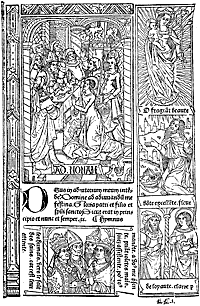
St. Michel, at the sign of the " Unicorn," he sold his stock to Gilles Remacle about the beginning of the sixteenth century.
Thielman Kerver in his own works shows himself as the rival of Simon Vostre. The Hardouins, who followed the same profession, do not appear to have attained the success of their predecessors ; and, excepting in the Heures à l' Usage de Rome, published in 1503 by Gilles Hardouin on the Pont au Change, at the sign of the " Rose," they servilely imitated them. There was also among the disciples of Vostre William Eustache, bookseller to the King, " tenant la boutique dedans la grant salle du palais du costé de messeigneurs les présidens, ou sur les grans degrés du costé de la conciergerie à l'ymage St. Jean levangeliste." Eustache made use of the work of Pigouchet and Kerver, not to mention the printers of the end of the fifteenth century.
We have named the principal, the fortunate ones ; but what becomes of the crowd of other publishers whose hopes vanished before the success of Vostre and Verard ? There were Denis Meslier, with his quarto Heures de Bourges, and Vincent Commin, bookseller of the Rue Neuve Notre Dame, who thus appealed to his customers :—
|
" Qui veult en avoir ? On en treuve A tres grand marché et bon pris A la Rose, dans la rue Neuve De Nostre-Dame de Paris." |
But if books of this kind found vogue and a large
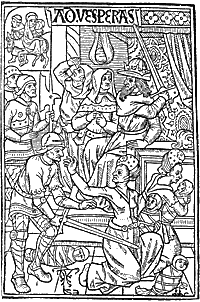
sale at this epoch, the dealers did not keep to pious publications only. By a singular mixture of the sacred and the profane, the bookmen put on sale on their stalls the / p.84 / " Decameron" of Boccaccio as well as the " Hours of the Immaculate Virgin," and the purchasers thought fit to make the acquaintance of the one as well as the other. Besides, the end of the fifteenth century had its literary preferences, its alluring titles, its attractive frontispieces. At the commencement of the present century double titles—"Atala ; or, The Child of Mystery;" "Waverley ;
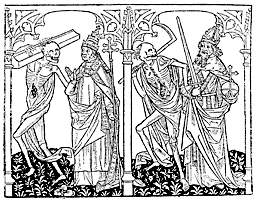
or, Sixty Years Since"—were common, although now out of fashion. Since then came books of travels—Voyages au Pays des Milliards, etc. In the fifteenth century, and even since the fourteenth, a series of titles was in public favour. There was first the Débats, or " Dialogues :" Débat de la Dame et de l'Escuyer, Paris, 1490, folio ; " Dialogue of Dives and Pauper," / THE DANCES OF DEATH. p.85 / London, Richard Pynson, 1493 ; and many other eccentric titles. There came also thousands of complaintes, a kind of lay in verse or prose ; blasons, light pieces describing this or that thing ; doctrinals, that had nothing to do with doctrine. And among the most approved subjects, between the piety of some and the gaiety of others, the Dances of Death established themselves firmly, showing, according to the hierarchy of classes
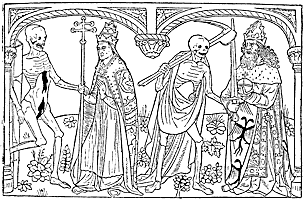
then prevalent, Death taking the great ones of the earth, torturing equally pope, emperor, constable, or minstrel, grimacing before youth, majesty, and love. Long before printing appeared, the Dances of Death took the lead ; they were some consolation for the wretched against their powerful masters, the revenge of the rabble against the king ; they may be seen painted, sculptured, illuminated, when engraving was not there to multiply their use ; they may be seen largely dis- / p.86 / played on walls, sombre, frightful, at Dresden, Leipzig, Erfurt, Berne, Lucerne, Rouen, Amiens, and Chaise-Dieu. It was the great human equality, attempted first by the French, then by the inimitable Holbein.
We can imagine the impression these bitter ironies made on the oppressed and disdained lower classes. The first " Dance of Death" was produced by Guyot Marchant in 1485, in ten leaves and seventeen engravings, in folio, with Gothic characters. Marchant describes himself as " demeurant en Champ Gaillart à Paris le vingt-huitiesme jour de septembre mil quatre cent quatre-vingtz et cinq." The book must have gone off rapidly, for it was republished in the following year, with additions and new engravings. French illustration was already moving forward, as may be judged by the reproductions here given from the folio edition of 1486. Pope and emperor, glory and power, are led and plagued by Death, hideous Death, with open body and frightful grin.
We could wish that the tendencies and processes of what may be called the second generation of printers were well understood. In a few years they surmounted the difficulties of their art, and made the Book a model of elegance and simplicity. The smallest details were cared for, and things apparently the most insignificant were studied and rendered practical. Speaking of titles, an enormous progress was here made in the publications of the end of the century. In Italy the subjects of decoration ordinarily formed a framework for the front page, wherein were included useful indications. The most ancient specimen of this kind has already been referred to. A model of this species is the " St. Jerome," / PRINTERS' MARKS. p.87 / published at Ferrara by Lorenzo Rossi, of Valenza, in 1497, folio ; the title, much adorned, is in Gothic letters ; the engraved initial is very adroitly left in outline, so as not to burden or break the text.
In Germany there was already the appearance of bad taste and prodigality, the letters crossing each other,
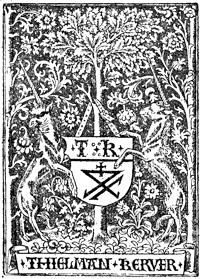
|
In France the first page gave the most circumstantial indications of the contents of the work, the name and abode of the printer and bookseller. Often these titles were ornamented with movable frameworks, printed in Gothic, sometimes in two colours, which necessitated two printings, one for the black and one for the red ink. The mark of the printer or publisher generally appeared, and it was nearly always a charming work. These French marks were all more or less treated heraldically ; that is to say, the initials / p.88 / occupy a shield, sustained by supporters and cut with extreme care. The first was that of Fust and Schoeffer at Mayence, of admirable simplicity and grace. In France this early specimen of the trade mark took with Simon Vostre and Verard the shape of delicate illustrations, finely designed and carefully engraved ; but the custom of allusive marks did not prevail, as we shall have occasion to see, until the sixteenth century. The mark of Pigouchet has already been given ; that of Thielman Kerver is conceived in the same principles of taste and art. The sign of his house being the " Unicorn," Kerver took as supporters to his shield two unicorns affrontées.
In these colophons are found philosophic aphorisms, satirical remarks, marvels of poetry. A certain bookseller paid court to the powerful university, which dispensed glory and riches to the poor tradesmen by buying many books. Andrew Bocard engraved on his mark this flattery as a border :—
|
"Honneur au Roy et à la court, Salut à l'université Dont nostre bien procède et sourt. Dieu gart de Paris la cité !" |
|
" Arte et expensis vigilique cura Treschel explevit opus hoc Joannes, Mille quingentos ubi Christus annos Sex minus egit. |
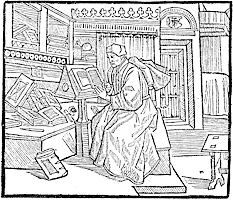
|
Jamque Lugduni juvenes, senesque, Martias nonas celebres agebant Magna Reginæ quia prepotenti Festa parabant." |
The portrait is another element of illustration, the figure of the author prefixed to his work. It had / p.90 / already been a custom in the manuscripts to paint on the first leaf of the work the likeness of him who composed it, frequently in the act of presenting his book to some noble patron ; and in this way is often preserved the only known portrait of either patron or author. Printing and engraving rendered these effigies more common, the portraits of one often served for another, and the booksellers used them without very much scruple. As we shall see later, this became in the sixteenth century a means of illustrating a book plainly, but only at the time when the portrait, drawn or painted, commenced to be more widely used. Previously the clichés of which we speak went everywhere, from the Italians to the French, from Æsop to Accursius ; these uncertain physiognomies began with the manuscript romances of chivalry, from whence they were servilely copied in typography. From the first the Italians mixed the ancient and the modern. Thus in a Breviarium, printed in 1478, there is an engraved portrait of Paul Florentin. On the same principle, the portrait of Burchiello, an early Italian poet, was later reproduced in England as a likeness of William Caxton.
In France the author is often represented writing, and it was so up to the middle of the sixteenth century. In an edition of Des Cas des Nobles Hommes, by Jean Dupré, in 1483, Boccaccio is represented seated, having before him his French translator, Laurent de Premierfait. This plate is one of the oldest representations of authors in French books. In the Roman de la Rose, first edition of Paris and Lyons, in folio, probably published by William Leroy about 1485, William de Lorris, the author, is shown in his bed :—
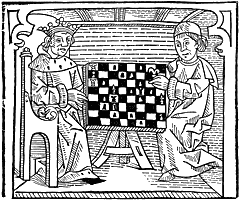
|
" Une nuyt comme je songeoye, Et de fait dormir me convient, En dormant un songe m'advint. . . ." |
There is also a portrait of Alain Chartier in his Faits, / p.92 / printed in 1489. In the Terence of Treschel, of Lyons, in 1493, we see a grammarian of the fifteenth century in a furnished room of the time occupied in writing at a desk ; this is Guy Jouvenal, of Mans, the author of the commentary.
While this good work was progressing so nobly in France, Italy, and Germany, the typographers of England
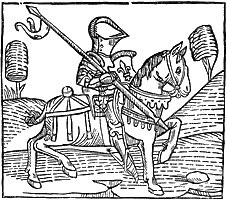
were by no means idle, although the illustration of the Book in the fifteenth century was not there so forward. William Caxton had produced over sixty works, the colophons of many of them revealing much of the personal life and character of the first English printer. Some of them were ornamented with woodcuts ; we / BOOKS PRINTED BY CAXTON. p.93 / reproduce two from the "Game and Playe of the Chesse," printed in folio, about 1476. The first represents a king and another person playing at chess ; the smaller cut is a representation of the knight, who is thus described in Caxton's own words : " The knyght ought to be maad al armed upon an hors in suche wise that
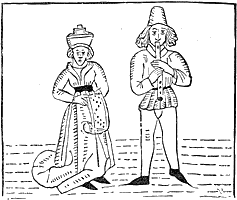
he have an helme on his heed and a spere in his right hond, and coverid with his shelde, a swerde and a mace on his left syde, clad with an halberke and plates tofore his breste, legge harnoys on his legges, spores on his heelis, on hys handes hys gauntelettes, hys hors wel broken and taught, and apte to bataylle, and coveryd with hys armes." The other Caxton block which we / p.94 / reproduce is a representation of music from the " Mirrour of the World," a thin folio volume of one hundred leaves
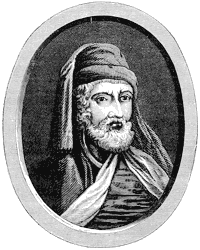
printed in 1481, with thirty-eight woodcuts. These specimens will serve to show the rudimentary character of English wood engraving in the fifteenth century. No / FIRST ENGLISH PRINTERS. p.95 / authentic portrait of Caxton is known, and the one that is generally accepted is really a portrait of an Italian poet, Burchiello, taken from an octavo edition of his work on Tuscan poetry, printed 1554 ; this was copied by Faithorne for Sir Hans Sloane as the portrait of Caxton, and was reproduced by Ames in his " Typographical Antiquities," 1749. Lewis prefixed the portrait here given to his " Life of Mayster Willyam Caxton," 1737, which is a copy of Faithorne's drawing
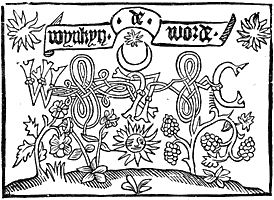
with some alterations. John Lettou and William Machlinia issued various statutes and other legal works.
Wynken de Worde continued printing up to 1534, and issued over four hundred works. He used no less than nine different marks, all of them bearing Caxton's initials, evidencing the regard of the pupil for his master ; the mark which we reproduce is one of rare occurrence. Richard Pynson began in 1493, and continued well into the sixteenth century, and was one of the first of the " privileged" printers, authorised to / p.96 / issue the legal and parliamentary publications. One of the marks used by him is here reproduced. Julian Notary began in 1498. The only style of illustration used by any of these early printers was the woodcut, and of this there was very little beyond the title-page and printer's mark. The artistic form of the Book originated on the Continent, but England was not slow to adopt it and fashion it to her own ends.
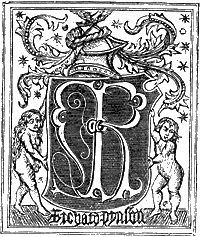
Thus was printing spread abroad, carrying with it to the countries where it was established the rules of an unchangeable principle ; but, according to its surroundings, it was so transformed in a few years that its origin was no longer recognised. It was light in Italy, heavy in Germany, gay in France. Painting, of which it was accidentally the issue, returned to it under / THE FIRST PRINTERS. p.97 / the form of illustration a short time after its first and fruitful essays. The Gothic character, generally used in Germany, continued in France with the Vostres, the Verards, and others up to the middle of the sixteenth century, although the first artisans before this used Roman type ; it was also the prevailing type used in English books. In Italy it was Jenson, a Frenchman, who gave to the matrix the alphabet preserved to the present time ; and it was the Venetians and Florentines who learned before all others the art of judicious ornamentation of the Book. The French came very near perfection, thanks to their printers and booksellers, at the end of the century ; and the Germans found illustrious artists to scatter their compositions in their large, heavy works.
